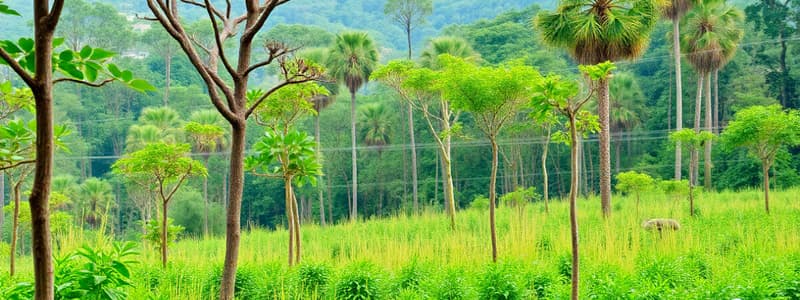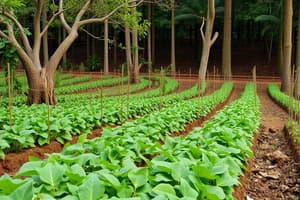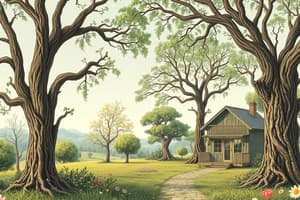Podcast
Questions and Answers
What is agroforestry?
What is agroforestry?
A collective name for land-use systems and technologies where woody perennials (trees, shrubs, palms, bamboos, etc.) are deliberately used in the same land management unit as agricultural crops and/or animals either in some form of spatial arrangement or temporal sequence, and in which there are both ecological and economical interactions between the different components.
What are the problems associated with climate change?
What are the problems associated with climate change?
Land conversion from forest to industrial, subdivision and recreational area; land degradation, loss of forest cover; irresponsible mining; increase in upland population.
List issues related to laws and policies regarding agroforestry projects.
List issues related to laws and policies regarding agroforestry projects.
Law implementation of laws related to agroforestry projects; legal constraints; lack of coordination between the governmental sectors; low adoption rate of agroforestry projects; lack of budget allocation; and land issues.
Define trees on farm.
Define trees on farm.
Define integrated agriculture and forestry.
Define integrated agriculture and forestry.
Define economic and ecological integration.
Define economic and ecological integration.
Define land use.
Define land use.
There is a _____ behind the combination of trees with crops, livestock, or both.
There is a _____ behind the combination of trees with crops, livestock, or both.
Trees are _____ with crops or livestock or both on the same parcel of land and managed as a unit.
Trees are _____ with crops or livestock or both on the same parcel of land and managed as a unit.
Agroforestry takes advantage of the biophysical and physical _____ among the components to achieve the farmer's goal of increased harvests.
Agroforestry takes advantage of the biophysical and physical _____ among the components to achieve the farmer's goal of increased harvests.
Agroforestry needs _____ management, such as cultivation, fertilization, irrigation, and pruning, to maintain its productive and protective functions.
Agroforestry needs _____ management, such as cultivation, fertilization, irrigation, and pruning, to maintain its productive and protective functions.
Agroforestry normally involves two or more species of plants (or plants and animals), at least one of which is a woody perennial
Agroforestry normally involves two or more species of plants (or plants and animals), at least one of which is a woody perennial
An agroforestry system always has two or more outputs
An agroforestry system always has two or more outputs
The cycle of an agroforestry system is always more than one year
The cycle of an agroforestry system is always more than one year
Even the simplest agroforestry system is more complex, ecologically (structurally and functionally) and economically, than a mono-cropping system.
Even the simplest agroforestry system is more complex, ecologically (structurally and functionally) and economically, than a mono-cropping system.
There must be a significant interaction (positive and/or negative) between woody and non-woody components of the system, ecological and/or economic.
There must be a significant interaction (positive and/or negative) between woody and non-woody components of the system, ecological and/or economic.
What are the criteria for good agroforestry design?
What are the criteria for good agroforestry design?
Agroforestry is monoculture farming, the practice of growing only one type of crop on a certain area of land, nor a mix of monoculture crops.
Agroforestry is monoculture farming, the practice of growing only one type of crop on a certain area of land, nor a mix of monoculture crops.
Agroforestry should be seen as the solution to all challenges faced by farmers or local communities.
Agroforestry should be seen as the solution to all challenges faced by farmers or local communities.
Which of the following is the correct structural basis of agroforestry?
Which of the following is the correct structural basis of agroforestry?
Which of the following is the correct functional basis of agroforestry?
Which of the following is the correct functional basis of agroforestry?
Which of the following is the correct Socio-Economic basis of agroforestry?
Which of the following is the correct Socio-Economic basis of agroforestry?
Which of the following is the correct Ecological spread of agroforestry?
Which of the following is the correct Ecological spread of agroforestry?
Match the following systems with their components
Match the following systems with their components
What does the spatial arrangement of agroforestry systems refer to?
What does the spatial arrangement of agroforestry systems refer to?
What does the temporal sequence of agroforestry systems refer to?
What does the temporal sequence of agroforestry systems refer to?
Match the temporal sequences with their definitions:
Match the temporal sequences with their definitions:
What are the two roles of trees in agroforestry systems?
What are the two roles of trees in agroforestry systems?
List five productive roles of woody perennials (trees).
List five productive roles of woody perennials (trees).
List three protective roles of woody perennials (trees).
List three protective roles of woody perennials (trees).
List three chemical properties of protective roles of woody perennials (trees)
List three chemical properties of protective roles of woody perennials (trees)
What are indigenous agroforestry systems?
What are indigenous agroforestry systems?
What is fallow system/swidden agriculture?
What is fallow system/swidden agriculture?
What are the Ikalahans known for?
What are the Ikalahans known for?
What are the stages of fallow system of the Hanunuos
What are the stages of fallow system of the Hanunuos
What is THE NAALAD IMPROVED FALLOW SYSTEM?
What is THE NAALAD IMPROVED FALLOW SYSTEM?
What is the Rice Terraces -Forest System known as
What is the Rice Terraces -Forest System known as
What is Alley cropping?
What is Alley cropping?
What are the procedures for establishment of alley cropping?
What are the procedures for establishment of alley cropping?
Which of these is NOT a good characteristic for alley cropping trees?
Which of these is NOT a good characteristic for alley cropping trees?
What is Multistorey?
What is Multistorey?
What does ICRAF defines live fencing as?
What does ICRAF defines live fencing as?
What is the purpose of live fence?
What is the purpose of live fence?
What is windbreak?
What is windbreak?
List three benefits of planting windbreaks
List three benefits of planting windbreaks
What is Taungya?
What is Taungya?
What is the Silvopastoral?
What is the Silvopastoral?
Flashcards
What is agroforestry?
What is agroforestry?
Land-use systems integrating trees with crops and/or animals, ecologically and economically.
What defines good agroforestry design?
What defines good agroforestry design?
Increased output, improved land conservation, and better resource use.
What is Monoculture?
What is Monoculture?
Farming that grows only one type of crop on a certain area of land
What is the basis of classification of agroforestry systems?
What is the basis of classification of agroforestry systems?
Signup and view all the flashcards
What is protective role of trees in agroforestry?
What is protective role of trees in agroforestry?
Signup and view all the flashcards
What is Indigenous Agroforestry System
What is Indigenous Agroforestry System
Signup and view all the flashcards
What is Fallow System/Swidden Agriculture?
What is Fallow System/Swidden Agriculture?
Signup and view all the flashcards
What is Alley Cropping System?
What is Alley Cropping System?
Signup and view all the flashcards
What is Multistorey System?
What is Multistorey System?
Signup and view all the flashcards
What are windbreaks?
What are windbreaks?
Signup and view all the flashcards
Study Notes
- Agroforestry involves the deliberate integration of woody perennials with agricultural crops and/or animals on the same land management unit.
- It acknowledges the ecological and economic interactions among different components of the system.
Problems Addressed by Agroforestry
- Climate Change
- Land conversion from forest to industrial, subdivision, and recreational areas
- Land degradation and loss of forest cover
- Irresponsible mining
- Increase in upland population
Issues Affecting Agroforestry
- Laws and policies including implementation and legal constraints
- Lack of coordination between governmental sectors
- Low adoption rate of agroforestry projects
- Lack of budget allocation
- Land issues
History of Agroforestry
- In Europe, forests were clear-cut, burned, and cultivated for food crops until the Middle Ages.
- Tropical American societies recreated forest-like conditions to utilize forest ecosystem benefits.
- The Hanunoo people of the Philippines practiced "shifting" cultivation.
- The Yoruba people of western Nigeria mixed herbaceous, shrub, and tree crops to conserve human energy.
Agroforestry Definitions
- Trees on farm includes combinations of trees with crops, livestock, or both.
- Integrated agriculture and forestry combines agriculture and forestry.
- Economic and ecological integration of sustainability and supporting livelihoods by increasing income, diversifying products, reducing costs, and mitigating price risks.
- Land use: The different ways land uses are combined with the function of forest trees make up an agroforestry system.
The 4 "I"s of Agroforestry
- Intentional: The combination of trees with crops/livestock is purposeful.
- Integrated: Trees are integrated with crops/livestock on the same land and managed as a unit.
- Interactive: Takes advantage of biophysical and physical interactions among components.
- Intensive: Needs intensive management to maintain productivity and protective functions.
Basic Concept of Agroforestry
- Involves two or more species of plants (or plants and animals), at least one of which is a woody perennial
- An agroforestry system always has two or more outputs
- The cycle of an agroforestry system is always more than one year
- Even the simplest agroforestry system is more complex than a mono-cropping system.
- Significant interaction (positive/negative) between woody and non-woody components.
Criteria of Good Agroforestry Design
- Productivity: Includes increased output of tree products, improved crop yields, and increased labor efficiency.
- Sustainability: Can achieve and maintain conservation and fertility goals indefinitely.
- Adoptability: Acceptability.
What Agroforestry Is Not
- Monoculture: It is not monoculture farming or a mix of monoculture crops.
- Solution to all: Not necessarily be the solution to all challenges faced by farmers or local communities.
- Something New: Farmers have been using agroforestry techniques for centuries.
Basis of Classification of Agroforestry Systems
- Based on structural, functional, socio-economic, and ecological spread.
Structural Basis
- Agrisilvicultural systems consist of trees with crops
- Silvopastoral systems involve trees with animals and/or pasture
- Agrosilvopastoral systems combine trees, crops, and animals or pasture
Arrangement of Components
- Spatial including horizontal and vertical aspects, such as arrangement of woody perennials, non-woody vegetation, and livestock.
- Temporal refers to the time and manner crops are cultivated, either simultaneously or sequentially.
Types of Spatial Arrangement
- Dense mixed stands (homegarden)
- Sparse mixed stands (silvopastoral systems)
- Zonal or strips
Functional Basis
- Productive Role: Includes output usually for single commodity for sale.
- Protective Role: Protecting and maintaining the site to perpetuate/continue its productive capacity.
Socio-Economic Basis
- Commercial: Production of output, usually a single commodity for sale, is the major aim
- Subsistence: Land use is directed at satisfying basic needs and managed mainly by the owner
Temporal Arrangement
- Concomitant: Components stay together for a certain period, e.g., Taungya system.
- Intermittent: Annual crops are grown, e.g., rice under coconut trees.
Ecological Spread
- Suitability of the systems on certain environmental conditions for arid/semi-arid regions, tropical highlands, and lowland humid tropics.
Role of Trees in Agroforestry
- Trees and woody perennials are the basic feature of agroforestry and distinguish production systems from pure agriculture.
Productive Role of Trees
- Wood: Firewood/Fuel, timber, pulpwood
- Non-wood: Fruits, Leaf meal/fodder/forage, Resin/latexes, Medicinal plants, Food
Protective Roles of Trees
- Restore and maintain soil fertility.
- Prevents soil erosion and promotes water conservation.
- Modifies microclimate.
- Acts as a wind break
- Serves as live fence.
Physical and Chemical Properties of Trees
- Improves soil structure and water holding capacity through organic matter accumulation
- Provides additional soil nutrients via litterfall, nitrogen fixation, and atmospheric inputs.
- Trees use nitrogen fixing.
Indigenous Agroforestry System
- Agroforestry systems that have been in existence for generations.
- Practiced by communities living close to the forest or developed by farmers themselves in a certain locality.
Fallow System/Swidden Agriculture
- Agroforestry fallow system or swidden cultivation is the oldest form of agroforestry.
- Land is cleared, burned, and planted with agricultural crops; later it is left under fallow.
- The land left after crop cultivation becomes unproductive and is usually covered with vegetation
- Key to sustainability is the length of the fallow.
The Fallow System of Ikalahans
- Indigenous people in the province of Nueva Vizcaya, Philippines, known for combining cultivation (2-3 years) and fallow (17 years).
- Farmers practice soil erosion control called "gen-gen".
- Known for their environmentally sustainable practices such as day-og and gengen composting techniques
- Pang-omis expedite the fallow period
- Balkah contour line of deep rooted plants which trap eroded topsoil
System of the Hanunuos
- Found in Mindoro Oriental and practice a very intensive intercropping system.
- They practice Intercropping of annuals under perennials
- Has two stages of the system consisting of low forest, and high forest fallow.
Naalad System.
- System developed in a small village in central Philippines.
- rotational system using tree species as the fallow species.
- Naalads plant Ipil-ipil along tree strips to hasten the fallow period.
- the ipil ipil are cut and the branches piled along the contours to form a fascine like structure which they called balagbag or babag function is for soil erosion
Mulitstory System
- Good example is homegarden where varieties of crops are interplanted around the house.
Rice Terraces-Forest System
- Called "payoh"-pinugo"/"hayokong"/"hino-ub" is a unique type of indigenous agroforestry system practiced by the Ifugao ethnic tribes
- Managed by clan, family or group of people.
Alley Cropping System
- Agroforestry system that involves planting of hedgerows along the contour.
- Agricultural crops in the alleys formed between two hedgerows.
Purpose of Alley Cropping
- Produce tree and/or shrub products along with crops/forages.
- improve utilization and recycling of soil nutrients.
- Reduce reduce surface water runoff and erosion, subsurface water quality, improve utilization and recycling of soil nutrients.
- Provide or enhance wildlife habitat.
- Create biological Pest Management habitat
Establishment Procedures of Alley Cropping
- Locating of the contour lines
- Planting of hedgerows
- Can use legumes species, red calliandra, madre de cacao, cassia spectabilis and ipil-ipil.
- grass or other plants used as hedgerows
Pruning/Maintenance of Hedgerows in Alley Cropping System
- hedgerow intervals and pruning maintanence is necessary
- agricultural crops are inserted between the alleys
Characteristics of GOOD Alley Cropping Trees
- Light, open crown that lets sunlight through
- Ability to resprout quickly after pruning
- A resistance to drought, flooding, soil variability and other climatic hazards, and deep trusthing tap-root system
- Few and shallow lateral roots. (or prunable) ability to aassist nitrogen fixation
Strength and Weakness of Alley Cropping
- soil and water runoff or erosion through improvement of the physical and chemical properties of the soil
- Yield are expected to increase
Multistorey
- combination that is characterized by at least two vertical canopy layers
- tries to imitate tropical rainforest, there is a better use of light, space and soil.
Types of Multi-Storey
- Indigenous multistorey system and coconut based multistorey system in the philippines
- Mahogany + Agricultural crops and rain tree + coofee
- Paraserianthes Falcataria + coffee/abaca
Trees in Multi-Storey Systema
- Tree are basically used as canopy crop to:provide shade to understorey crops, provide valuable products such as wood
- Trees maintain soil fertility, and help control soil erosion and increase water and nitrogen input
Criteria of Multistorey system for tree selection
- needs to have multiple uses and not cast too much shade
- nitrogen fixing crops with high small, open crown and sparse foliage needs
Strength and Weakness of Multistorey systema
- has optimum use for water and conservation
- more efficient nutrients and good diversity is involved
- needs and has many inputs and involves with other current practices involved
Live Fence / Boundary Planting
- very common practice in the rural areas.
- Live barriers are thicker more densely spaced fences that may include a number of different species and usually do not support other fencing materials.
Purpose of Boundary/Live Fences
- keep-out animals into their farm/homestead and demarcate areas
Chracteristics/Boundary Planting
- drough and drought resistent and tolerate injuries
- grow fast and easly to establish and are compatable
Windbreak System
- narrow strips of vegetation, usually trees, shrubs and/or grasses strategically
- need to be semi-permeable, letting some wind through and not blocking the wind entirely
Benefit of Tree Breaks
- Improve, quality of crop and yield by portecting from wind damage conservation of moisture by erosion
Taungya System
- Is a Burmese word which means hill (taung) cultivation (ya)
- Farmers plant raise agricultural crops between rows of forest tree species simultaneously.
Silvopastoral
- Practice of combining forestry and grazing of domesticated animals
- Not as widespread in the Philippines compares to arid and semi-Arid regions where grassland are extensive.
- The trees are managed for high value sawlogs and, at the same time, provide shade and shelter for the livestocks and forage, reducing stress and sometimes increasing forage production
Studying That Suits You
Use AI to generate personalized quizzes and flashcards to suit your learning preferences.




